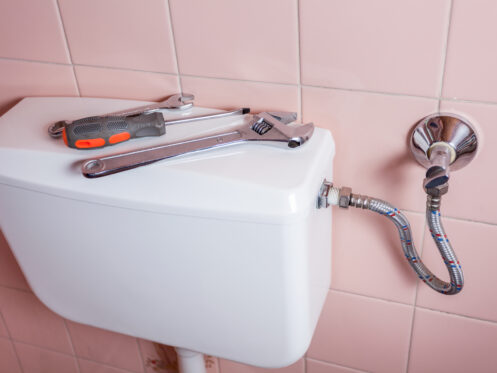Toilet issues are common, and they can cause Glendale, AZ homeowners a lot of inconvenience and frustration. Knowing how to fix these problems yourself saves you time and money. However, although DIY toilet fixes can resolve several issues, they can’t fix all of them.
This guide offers 12 practical solutions to common toilet problems that you can try to handle on your own. Whether you’re dealing with a running toilet or a weak flush, these simple repairs can make a tremendous difference. Let’s take a look at the top 12 DIY fixes that will help you keep your toilet in optimal condition.
1. Running Toilet Repairs
A running toilet wastes water and increases your utility bill. Typical causes include a faulty flapper or fill valve. To fix this, remove the tank lid, and inspect the flapper for wear or misalignment. If it is damaged, turn off the water supply, drain the tank, and replace the old flapper with a new one.
Should you determine that the issue is related to the fill valve, adjust its height to match the water level. If this doesn’t work, replace the valve entirely. Test your fix by flushing the toilet and seeing if the running stops. These steps should restore your toilet to its normally functioning state.
2. Unclogging a Toilet
A clogged toilet can quickly snowball into a major hassle and even a serious health hazard. To unclog your toilet, use a plunger and create suction to dislodge the blockage. Ensure the plunger fully covers the drain hole, and make firm, consistent push-pull motions.
If that doesn’t work, you can try a toilet auger. Insert the auger into the bowl, cranking the handle to break up or retrieve the clog. Then flush to ensure the bowl is clear. For a chemical-free solution, pour a cup of baking soda into a bowl and add 2 cups of white vinegar. Let this mixture fizz for 30 minutes before flushing. If these measures don’t eliminate the blockage, you probably have a more deeply entrenched clog and will need professional assistance to clear it.
3. Reversing Weak Flushes
Weak flushes are aggravating, but they can’t be ignored. This problem frequently indicates a malfunctioning toilet. Common causes include clogged rim holes or improper water levels in your tank. Start by determining if the water is below the mark inside the tank. If the water level in the tank appears low, adjust the fill valve to raise it.
Next, check the rim holes under the toilet bowl’s edge for mineral buildup. Use a thin wire or a brush to clean these openings. Also, confirm that no obstructions are hindering the siphon jet at the bottom of the bowl.
4. Dealing With a Leaky Base
A leaking toilet base can introduce expensive water damage and floor issues. To manage this problem, first identify the source of your leak by drying the area and observing where water appears. Typical problem points include a worn wax ring or loose bolts.
Tighten the bolts on either side of the base with a wrench. Remember not to overtighten and crack the porcelain. If the leak persists, turn off your water supply, disconnect the bowl, and replace the old wax ring with a new one. Finally, reinstall the toilet carefully and attach it. If this doesn’t stop your leak, call our plumbers at Christian Brothers Air Conditioning Plumbing Electrical straight away to prevent further damage.
5. Fixing Phantom Flushes
Phantom flushing occurs when your toilet refills sporadically because you have a slow leak. This phenomenon is usually attributable to a faulty flapper valve or a warped seal. To diagnose this issue, check to see if water trickles into the bowl between flushes.
You can confirm this by adding food coloring to the tank. If the color seeps into the bowl, you definitely have a leak. If this is the case, turn off the water supply, and drain the tank. Inspect the flapper for wear, warping, or buildup, and replace it if necessary. Finally, test the repair to ensure the new flapper creates a tight seal.
6. Handling a Slow-Filling Tank
Slow-filling tanks are annoying because they leave you waiting an unnecessarily long time between flushes. Common causes include sediment buildup in the fill valve or low water pressure. To fix this, turn off your water supply, and flush the tank empty. Next, remove the valve cap, and inspect it for sediment or debris.
Clean your tank thoroughly with a brush, and rinse under running water. If these measures don’t improve the filling speed, replace the fill valve. You should also check your home’s water pressure. If you discover it’s low, address any broader issues with a professional plumber. If not, reassemble everything, turn the water back on, and test to ensure your tank fills faster.
7. Repairing a Sweating Toilet Tank
A sweating toilet tank is the result of condensation. This happens when cold water meets warm, humid air. Sweating tanks cause water damage. To prevent this, you’ll need to install a tank liner kit. Cut the water supply, empty your tank, and attach the insulating foam liner inside it, and. This extra liner will reduce the temperature differences.
An anti-sweat valve is another option. This solution helps combine warm and cold water entering the tank. You can install it on your toilet’s supply line. Remember to follow all the manufacturer’s instructions, and call a licensed plumber if you discover they’re beyond the scope of your expertise.
8. Stabilizing a Wobbling Toilet
A wobbling toilet usually indicates loose bolts or an underlying floor issue. You’ll need to check the flange bolts on either side of the toilet base to determine the exact problem. If your flange bolts are loose, crank them slowly to the right and avoid over-tightening so as not to crack the porcelain.
If the toilet still wobbles, insert plastic shims under the base to level it, then trim any excess shim material. Test the stability by gently pushing the toilet from different angles. If these steps don’t resolve the wobbling, inspect the floor underneath for rot or structural problems, and adjust as required.
9. Replacing a Broken Flush Handle
A broken flush handle will effectively disable your toilet. Fortunately, it’s not too challenging to fix. To confirm the precise issue, remove your tank lid, and evaluate the handle mechanism. If the lift chain is disconnected or tangled, reattach it to the handle arm, and adjust its length for correct operation. You’ll need to replace the handle, arm, or both if they appear cracked or broken.
Do this by unscrewing the mounting nut inside the tank. Remember that most toilet handles are reverse-threaded. Carefully remove the old handle and install the new one. Now, secure it with the mounting nut. Reattach the lift chain to the new handle. Don’t forget to leave enough slack for proper flushing. Lastly, test with a flush to verify that everything works as it should.
Ensuring an Optimally Functioning Toilet at Home
Whether you’re dealing with a running toilet, weak flushes, or other common issues, these DIY solutions let you save time and money. However, fixing a faulty toilet can be tricky, and if the job calls for professional assistance, our plumbers at Christian Brothers Air Conditioning Plumbing Electrical can help with toilet repair. Along with our expert plumbing services, we provide premium electrical and HVAC solutions.
Contact us today to learn how our team at Christian Brothers Air Conditioning Plumbing Electrical can handle all your plumbing, electrical, and air needs in Glendale and the surrounding areas.










